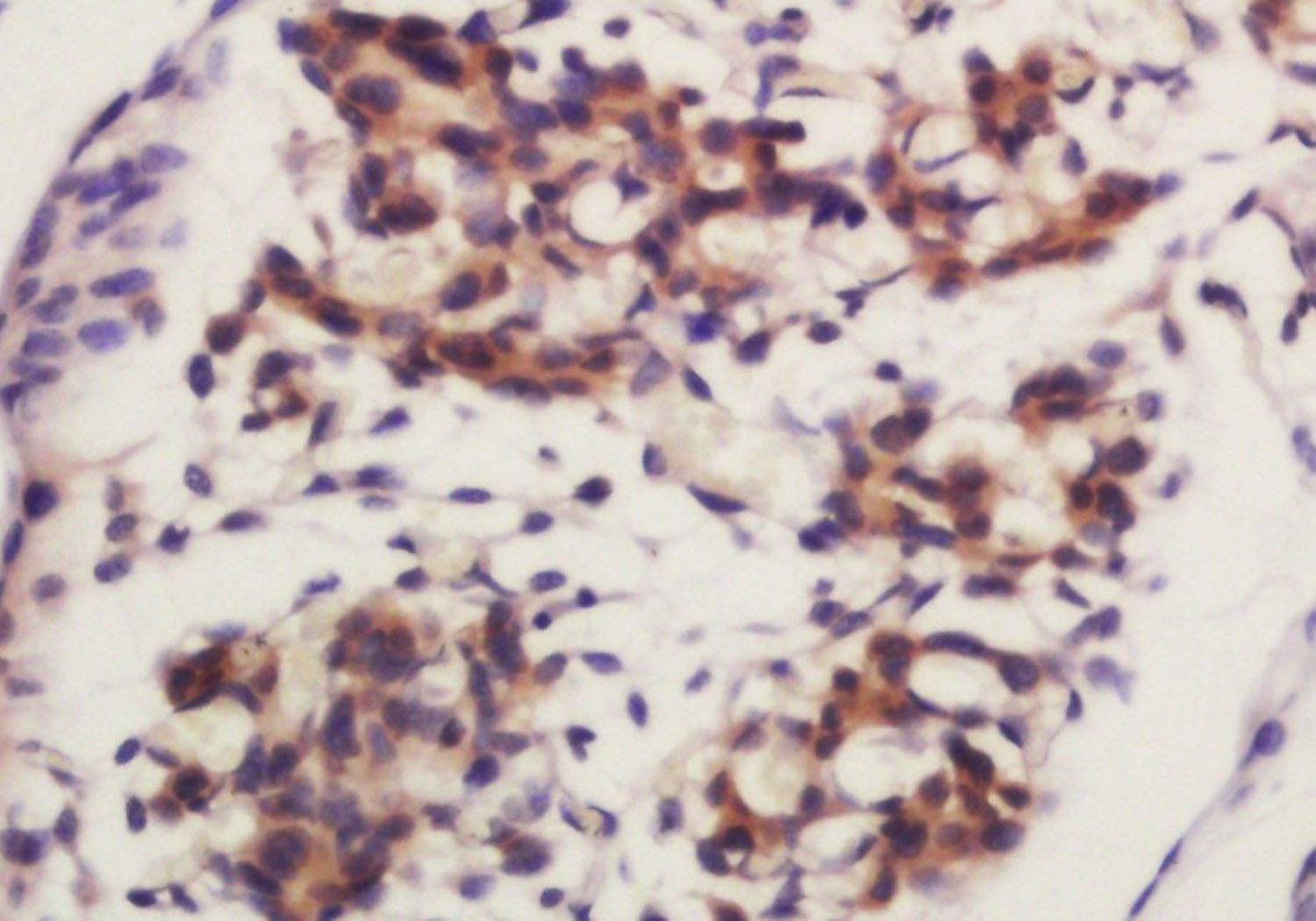
Rabbit Anti-FZD4 antibody
Frizzled 4; CD 344; CD 344 antigen; CD344; CD344 antigen; EVR1; FEVR; Frizzled (Drosophila) homolog 4; Frizzled 4; Frizzled family receptor 4; Frizzled homolog 4 (Drosophila); Frizzled-4; Fz 4; Fz-4; Fz4; FZD4S; FzE4; GPCR; hFz4; MGC34390; WNT receptor fr
View History [Clear]
Details
Product Name FZD4 Chinese Name CD344抗体 Alias Frizzled 4; CD 344; CD 344 antigen; CD344; CD344 antigen; EVR1; FEVR; Frizzled (Drosophila) homolog 4; Frizzled 4; Frizzled family receptor 4; Frizzled homolog 4 (Drosophila); Frizzled-4; Fz 4; Fz-4; Fz4; FZD4S; FzE4; GPCR; hFz4; MGC34390; WNT receptor frizzled 4; FZD4_HUMAN. literatures Research Area Tumour Cell biology Developmental biology Signal transduction Stem cells transcriptional regulatory factor The new supersedes the old Immunogen Species Rabbit Clonality Polyclonal React Species Mouse, (predicted: Human, Rat, Chicken, Dog, Pig, Cow, Horse, ) Applications WB=1:500-2000 ELISA=1:5000-10000 IHC-P=1:100-500 IHC-F=1:100-500 ICC=1:100-500 IF=1:100-500 (Paraffin sections need antigen repair)
not yet tested in other applications.
optimal dilutions/concentrations should be determined by the end user.Theoretical molecular weight 56kDa Cellular localization The cell membrane Form Liquid Concentration 1mg/ml immunogen KLH conjugated synthetic peptide derived from human Frizzled 4/CD344: 151-250/537 <Extracellular> Lsotype IgG Purification affinity purified by Protein A Buffer Solution 0.01M TBS(pH7.4) with 1% BSA, 0.03% Proclin300 and 50% Glycerol. Storage Shipped at 4℃. Store at -20 °C for one year. Avoid repeated freeze/thaw cycles. Attention This product as supplied is intended for research use only, not for use in human, therapeutic or diagnostic applications. PubMed PubMed Product Detail Frizzled-4 is a 537 amino acid protein encoded by the human gene FZD4. Frizzled-4 acts as a receptor for Wnt proteins. Most frizzled receptors are coupled to the beta-catenin canonical signaling pathway, which leads to the activation of disheveled proteins, inhibition of GSK-3 kinase, nuclear accumulation of beta-catenin and activation of Wnt target genes. A second signaling pathway involving PKC and calcium fluxes has been seen for some family members, but it is not yet clear if it represents a distinct pathway or if it can be integrated in the canonical pathway, as PKC seems to be required for Wnt-mediated inactivation of GSK-3 kinase. Both pathways seem to involve interactions with G-proteins. Frizzled-4 may be involved in transduction and intercellular transmission of polarity information during tissue morphogenesis and/or in differentiated tissues. Frizzled-4 also plays a critical role in retinal angiogenesis. Frizzled-4 is virtually ubiquitously expressed with greatest amounts found in adult heart, skeletal muscle, ovary, and fetal kidney.
Function:
Receptor for Wnt proteins. Most of frizzled receptors are coupled to the beta-catenin (CTNNB1) canonical signaling pathway, which leads to the activation of disheveled proteins, inhibition of GSK-3 kinase, nuclear accumulation of beta-catenin (CTNNB1) and activation of Wnt target genes. Plays a critical role in retinal vascularization by acting as a receptor for Wnt proteins and norrin (NDP). In retina, it can be both activated by Wnt protein-binding, but also by a Wnt-independent signaling via binding of norrin (NDP), promoting in both cases beta-catenin (CTNNB1) accumulation and stimulation of LEF/TCF-mediated transcriptional programs. A second signaling pathway involving PKC and calcium fluxes has been seen for some family members, but it is not yet clear if it represents a distinct pathway or if it can be integrated in the canonical pathway, as PKC seems to be required for Wnt-mediated inactivation of GSK-3 kinase. Both pathways seem to involve interactions with G-proteins. May be involved in transduction and intercellular transmission of polarity information during tissue morphogenesis and/or in differentiated tissues.
Subunit:
Interacts with MAGI3 and norrin (NDP). Component of a complex, at least composed of TSPAN12, FZD4 and norrin (NDP) (By similarity).
Subcellular Location:
Membrane; Multi-pass membrane protein. Cell membrane; Multi-pass membrane protein (By similarity).
Tissue Specificity:
Almost ubiquitous. Largely expressed in adult heart, skeletal muscle, ovary, and fetal kidney. Moderate amounts in adult liver, kidney, pancreas, spleen, and fetal lung, and small amounts in placenta, adult lung, prostate, testis, colon, fetal brain and liver.
Post-translational modifications:
Ubiquitinated by ZNRF3, leading to its degradation by the proteasome.
DISEASE:
Defects in FZD4 are the cause of vitreoretinopathy exudative type 1 (EVR1) [MIM:133780]; also known as autosomal dominant familial exudative vitreoretinopathy (FEVR) or Criswick-Schepens syndrome. EVR1 is a disorder of the retinal vasculature characterized by an abrupt cessation of growth of peripheral capillaries, leading to an avascular peripheral retina. This may lead to compensatory retinal neovascularization, which is thought to be induced by hypoxia from the initial avascular insult. New vessels are prone to leakage and rupture causing exudates and bleeding, followed by scarring, retinal detachment and blindness. Clinical features can be highly variable, even within the same family. Patients with mild forms of the disease are asymptomatic, and their only disease-related abnormality is an arc of avascular retina in the extreme temporal periphery.
Similarity:
Belongs to the G-protein coupled receptor Fz/Smo family. Contains 1 FZ (frizzled) domain.
SWISS:
Q9ULV1
Gene ID:
8322
Database links:Entrez Gene: 8322 Human
Entrez Gene: 14366 Mouse
Omim: 604579 Human
SwissProt: Q9ULV1 Human
SwissProt: Q61088 Mouse
Unigene: 591968 Human
Unigene: 86755 Mouse
Unigene: 48736 Rat
Product Picture
Antigen retrieval: citrate buffer ( 0.01M, pH 6.0 ), Boiling bathing for 15min; Block endogenous peroxidase by 3% Hydrogen peroxide for 30min; Blocking buffer (normal goat serum,C-0005) at 37℃ for 20 min;
Incubation: Anti-Frizzled 4 Polyclonal Antibody, Unconjugated(SL13217R) 1:200, overnight at 4°C, followed by conjugation to the secondary antibody(SP-0023) and DAB(C-0010) staining
Bought notes(bought amounts latest0)
No one bought this product
User Comment(Total0User Comment Num)
- No comment



 +86 571 56623320
+86 571 56623320
 +86 18668110335
+86 18668110335

